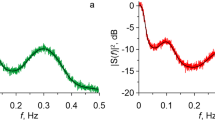Abstract
Standard time and frequency parameters of heart rate variability (HRV) describe only linear and periodic behaviour, whereas more complex relationships cannot be recognised. A method that may be capable of assessing more complex properties is the non-linear measure of ‘renormalised entropy’. A new concept of the method, REAR, has been developed, based on a non-linear renormalisation of autoregressive spectral distributions. To test the hypothesis that renormalised entropy may improve the result of high-risk stratification after myocardial infarction, it is applied to a clinical pilot study (41 subjects) and to prospective data of the St George's Hospital post-infarction database (572 patients). The study shows that the new REAR method is more reproducible and more stable in time than a previously introduced method (p<0.001). Moreover, the results of the study confirm the hypothesis that on average, the survivors have negative values of REAR (−0.11±0.18), whereas the non-survivors have positive values (0.03±0.22, p<0.01). Further, the study shows that the combination of an HRV triangular index and REAR leads to a better prediction of sudden arrhythmic death than standard measurements of HRV. In summary, the new REAR method is an independent measure in HRV analysis that may be suitable for risk stratification in patients after myocardial infarction.
Similar content being viewed by others
References
Goldberger, A. L., Rigney, D. R., Mietus, J., Antman, E. M., andGreenwald, S. (1988): ‘Nonlinear dynamics in sudden cardiac death syndrome: heartrate oscillations and bifurcations’,Experientia,44, pp. 983–987
Haykin, S. (1983): ‘Nonlinear methods of spectral analysis’ (Springer Verlag, Berlin), pp. 73–123.
Klimontovich, Y. L. (1991): ‘Turbulent motion and structure of chaos’ (Kluwer Academic Publishers, Dordrecht)
Kopitzki, K., Warnke, P. C. andTimmer, J. (1998): ‘Quantitative analysis by renormalized entropy of invasive electroencephalograph recordings in focal epilepsy’,Phys. Rev. E. 58, pp. 4859–4864
Kurths, J., Voss, A., Witt, A., Saparin, P., Kleiner, H. J., andWessel, N., (1995): ‘Quantitative analysis of heart rate variability’,Chaos,5, pp. 88–94
Makikallio, T. H., Seppanen, T., Airaksinen, K. E., Koistinen, J., Tulppo, M. P., Peng, C. K., Goldberger, A. L., andHuikuri, H. V. (1997): ‘Dynamic analysis of heart rate may predict subsequent ventricular tachycardia after myocardial infarction’,Am. J. Cardiol.,80, pp. 779–783
Saparin, P., Witt, A., Kurths, J., andAnishenko, V. (1994): ‘The renormalized entropy- an appropriate complexity measure’,Chaos Solitons Fractals,4, pp. 1907–1916
Schafer, C., Rosenblum, M. G., Kurths, J., andAbel, H. H. (1998): ‘Heartbeat synchronized with ventilation’,Nature,392, pp. 239–240
Schreiber, T. (1997): ‘Detecting and analysing nonstationarity in a time series using nonlinear cross predictions’,Phys. Rev. Lett.,78, pp. 843–847
Task Force Europ. Soc. Cardiol. North Am. Soc. Pacing Electrophysiol. (1996): ‘Heart rate variability, standards of measurement, physiological interpretation, and clinical use’,Circulation,93, pp. 1043–1065
Voss, A., Kurths, J., andFiehring, H. (1992): ‘Frequency domain analysis of the highly amplified ECG on basis of maximum entropy spectral estimation’,Med. Biol. Eng. Comput.,30, pp. 277–282
Voss, A., Dietz, R., Fiehring, H., Kleiner, H. J., Kurths, J., Saparin, P., Vossing, H. J. andWitt, A. (1993): ‘High resolution ecg, heart rate variability and nonlinear dynamics: tools for high risk stratification’,Comput. Cardiol. pp. 261–264
Voss, A., Kurths, J., Kleiner, H. J., Witt, A., Wessel, N., Saparin, P., Osterziel, K. J., Schurath, R., andDietz, R. (1996): ‘The application of methods of non-linear dynamics for the improved and predictive recognition of patients threatened by sudden cardiac death’,Cardiovasc. Res.,31, pp. 419–433
Voss, A., Hnatkova, K., Wessel, N., Kurths, J., Sander, A., Schirdewan, A., Camm, A. J., andMalik, M. (1998): ‘Multiparametric analysis of heart rate variability used for risk stratification among survivors of acute myocardial infarction’,Pacing Clin. Electrophysiol.,21, pp. 186–192
Wessel, N., Voss, A., Kurths, J., Saparin, P., Witt, A., Kleiner, H. J., andDietz, R. (1994): ‘Renormalised entropy: a new method of nonlinear dynamics for the analysis of heart rate variability’,Comput. Cardiol., pp. 137–140
Wessel, N., Ziehmann, CH., Kurths, J., Meyerfeldt, U., Schirdewan, A., andVoss, A. (2000): ‘Short-term forecasting of life-threatening cardiac arrhythmias based on symbolic dynamics and finite-time growth rates’,Phys. Rev. E.,61, pp. 733–739
Author information
Authors and Affiliations
Corresponding author
Rights and permissions
About this article
Cite this article
Wessel, N., Voss, A., Kurths, J. et al. Evaluation of renormalised entropy for risk stratification using heart rate variability data. Med. Biol. Eng. Comput. 38, 680–685 (2000). https://doi.org/10.1007/BF02344875
Received:
Accepted:
Issue Date:
DOI: https://doi.org/10.1007/BF02344875




